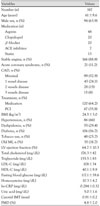1. Rathmann W, Giani G. Global prevalence of diabetes: estimates for the year 2000 and projections for 2030. Diabetes Care. 2004. 27:2568–2569.
2. Libby P, Ridker PM, Maseri A. Inflammation and atherosclerosis. Circulation. 2002. 105:1135–1143.
3. Pyorala K, Laakso M, Unsitupa M. Diabetes and atherosclerosis: an epidemiologic view. Diabetes Metab Rev. 1987. 3:463–524.
4. Barziay JI, Spiekerman CF, Kuller LH, et al. Prevalence of clinical and isolated subclinical cardiovascular disease in older adults with glucose disorder. Diabetes Care. 2001. 24:1233–1239.
5. Bonora E, Formentini G, Calcaterra F, et al. HOMA-estimated insulin resistance is an independent predictor of cardiovascular disease in type 2 diabetic subjects: prospective data from the Verona Diabetes Complications Study. Diabetes Care. 2002. 25:1135–1141.
6. Matthews DR, Hosker JP, Rudenski AS, Naylor BA, Treacher DF, Turner RC. Homeostasis model assessment: insulin resistance and beta-cell function from fasting plasma glucose and insulin concentrations in man. Diabetologia. 1985. 28:412–419.
7. Katz A, Nambi SS, Mather K, et al. Quantitative insulin sensitivity check index: a simple, accurate method for assessing insulin sensitivity in humans. J Clin Endocrinol Metab. 2000. 85:2402–2410.
8. Lee SH, Choi SH, Kim HJ, et al. Cutoff values of surrogate measures of insulin resistance for metabolic syndrome in Korean non-diabetic adults. J Korean Med Sci. 2006. 21:695–700.
9. Kim ES, Han SM, Kim YI, et al. Prevalence and clinical characteristics of metabolic syndrome in a rural population of South Korea. Diabet Med. 2004. 21:1141–1143.
10. Kim DJ, Lee MS, Kim KW, Lee MK. Insulin secretory dysfunction and insulin resistance in the pathogenesis of Korean type 2 diabetes mellitus. Metabolism. 2001. 50:590–593.
11. Adler AI, Levy JC, Matthews DR, Stratton IM, Hines G, Holman RR. Insulin sensitivity at diagnosis of type 2 diabetes is not associate with subsequent cardiovascular disease (UKPDS 67). Diabet Med. 2005. 22:306–311.
12. Bonneti PO, Lerman LO, Lerman A. Endothelial dysfunction: a marker of atherosclerotic risk. Arterioscler Thromb Vasc Biol. 2003. 23:168–175.
13. Gnasso A, Irace C, Mattioli PL, Pujia A. Carotid intima-media thickness and coronary heart disease risk factors. Atherosclerosis. 1996. 119:7–15.
14. Kang MI, Kim WS, Kwon TG, Hyun DW, Bae JH. The serum lipid level is associated with intimal thickness of the carotid artery for patients with coronary atherosclerosis. Korean Circ J. 2007. 37:380–384.
15. Poli A, Tremoli E, Colombo A, Sirtori M, Pignoli P, Paoletti R. Ultrasonographic measurement of the common carotid artery wall thickness in hypercholesterolemic patients: a new model for the quantitation and follow-up of preclinical artherosclerosis in living human subjects. Atherosclerosis. 1988. 70:253–261.
16. Celermajer DS, Sorensen KE, Gooch VM, et al. Noninvasive detection of endothelial dysfunction in children and adults at risk of atherosclerosis. Lancet. 1992. 340:1111–1115.
17. Chambless LE, Folsom AR, Davis V, et al. Risk factors for progression of common carotid atherosclerosis: the artherosclerosis risk in communites Study, 1987-1988. Am J Epidemiol. 2002. 155:38–47.
18. Kim AS, Park WS, Ohrr HC, et al. Prevalence and management status of diabetes mellitus in Korea. Korean J Med. 2005. 68:10–17.
19. Cho JM, Kim CJ, Shin WS, et al. Clinical features and prognostic factors in Korean patients hospitalized for coronary artery disease (Catholic Heart Care Network Study). Korean J Med. 2007. 73:142–150.
20. Ohnishi H, Saitoh S, Ura N, et al. Relationship between insulin resistance and accumulation of coronary risk factors. Diabetes Obes Metab. 2002. 4:388–393.
21. Bae JH, Seung KB, Jung HO, et al. Analysis of Korean carotid intima-media thickness in Korean healthy subjects and patients with risk factors: Korea multi-center epidemiological study. Korean Circ J. 2005. 35:513–524.
22. Yoon HJ, Bae JH, Kim KY, Kim JK. Age, gender, and number of atherosclerotic risk factors are the independent factor of endothelial dysfunction in patients with coronary atherosclerosis. Korean Circ J. 2005. 35:302–308.
23. Giannini C, de Giorgis T, Scarinci A, et al. Obese related effects of inflammatory markers and insulin resistance on increased carotid intima media thickness in pre-pubertal children. Atherosclerosis. 2008. 197:448–456.
24. Makino H, Doi K, Hiuge A, et al. Impaired flow-mediated vasodilatation and insulin resistance in type 2 diabetic patients with albuminuria. Diabetes Res Clin Pract. 2008. 79:177–182.






 PDF
PDF ePub
ePub Citation
Citation Print
Print




 XML Download
XML Download